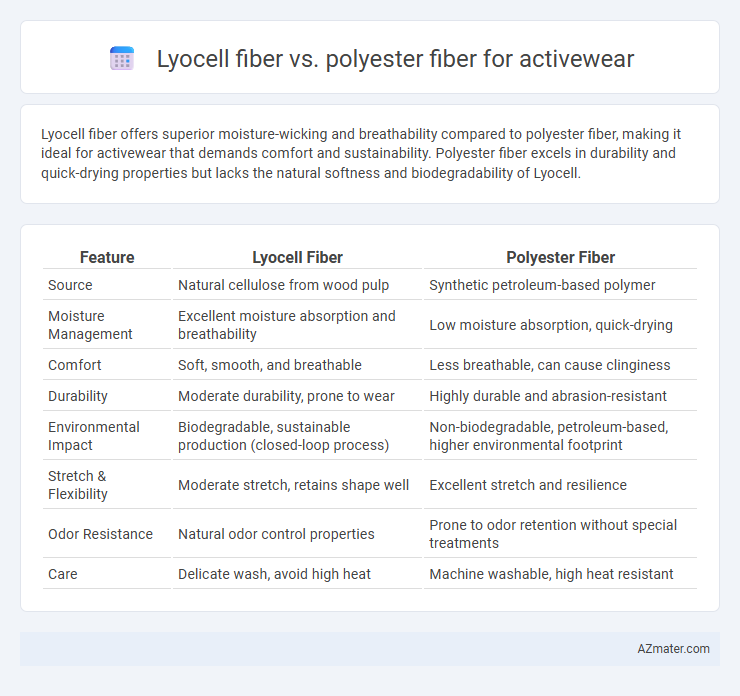Lyocell fiber offers superior moisture-wicking and breathability compared to polyester fiber, making it ideal for activewear that demands comfort and sustainability. Polyester fiber excels in durability and quick-drying properties but lacks the natural softness and biodegradability of Lyocell.
Table of Comparison
| Feature | Lyocell Fiber | Polyester Fiber |
|---|---|---|
| Source | Natural cellulose from wood pulp | Synthetic petroleum-based polymer |
| Moisture Management | Excellent moisture absorption and breathability | Low moisture absorption, quick-drying |
| Comfort | Soft, smooth, and breathable | Less breathable, can cause clinginess |
| Durability | Moderate durability, prone to wear | Highly durable and abrasion-resistant |
| Environmental Impact | Biodegradable, sustainable production (closed-loop process) | Non-biodegradable, petroleum-based, higher environmental footprint |
| Stretch & Flexibility | Moderate stretch, retains shape well | Excellent stretch and resilience |
| Odor Resistance | Natural odor control properties | Prone to odor retention without special treatments |
| Care | Delicate wash, avoid high heat | Machine washable, high heat resistant |
Introduction to Lyocell and Polyester Fibers
Lyocell fiber, derived from sustainably sourced wood pulp, offers excellent moisture-wicking, breathability, and biodegradability, making it an eco-friendly choice for activewear. In contrast, polyester fiber, a synthetic polymer made from petroleum-based products, is renowned for its durability, wrinkle resistance, and quick-drying properties, yet it is less breathable and non-biodegradable. Both fibers are widely used in activewear, with lyocell favored for comfort and environmental benefits, while polyester excels in performance and longevity.
Key Physical Properties Comparison
Lyocell fiber offers superior moisture absorption and breathability compared to polyester fiber, making it ideal for activewear that requires excellent sweat management. Polyester fiber excels in durability, wrinkle resistance, and quick-drying properties, providing long-lasting performance and shape retention during intense physical activities. The tensile strength of polyester is generally higher, while Lyocell provides a softer, more natural feel against the skin, enhancing comfort during extended wear.
Moisture Management and Breathability
Lyocell fiber offers superior moisture management by efficiently wicking sweat away from the skin and allowing rapid evaporation, keeping athletes dry during intense workouts. Its natural breathability promotes enhanced airflow compared to polyester fiber, which tends to trap heat and moisture, leading to discomfort. While polyester fibers provide durability and quick-drying properties, Lyocell's eco-friendly production and balanced moisture control make it an excellent choice for high-performance activewear.
Comfort and Skin Sensitivity
Lyocell fiber offers superior breathability and moisture-wicking properties compared to polyester fiber, enhancing comfort during activewear use by keeping the skin dry and cool. Its natural, hypoallergenic characteristics reduce the risk of irritation and skin sensitivity, making it ideal for individuals with sensitive skin or allergies. Polyester fiber, while durable and quick-drying, often traps heat and moisture against the skin, potentially leading to discomfort and increased skin irritation during prolonged physical activity.
Durability and Performance in Activewear
Lyocell fiber offers superior moisture-wicking properties and breathability, enhancing comfort during intense physical activities, while polyester fiber excels in durability, maintaining shape and resisting abrasion over time. Lyocell's natural cellulose structure provides softness and biodegradability but tends to wear down faster under repeated stress compared to polyester's synthetic resilience. For activewear demanding long-lasting performance and shape retention, polyester remains the preferred choice, whereas Lyocell excels in applications prioritizing sustainability and moisture management.
Environmental Impact and Sustainability
Lyocell fiber, derived from sustainably sourced wood pulp, offers a biodegradable and eco-friendly alternative to conventional polyester used in activewear, significantly reducing microplastic pollution. The closed-loop production process of Lyocell minimizes water and chemical usage, enhancing sustainability compared to polyester's petroleum-based manufacturing and high energy consumption. Choosing Lyocell activewear supports reduced carbon footprint and promotes circular fashion, contrasting with polyester's contribution to non-renewable resource depletion and long-term environmental waste.
Care, Maintenance, and Longevity
Lyocell fiber is highly breathable, moisture-wicking, and naturally resistant to wrinkles, requiring gentle machine washing in cold water and air drying to maintain its softness and durability in activewear. Polyester fiber offers superior strength and fast-drying properties, tolerates frequent washing at higher temperatures, and retains shape and color longer, making it low-maintenance for high-performance garments. Lyocell's biodegradability enhances its environmental appeal, while polyester's synthetic nature ensures extended longevity under rigorous use.
Odor Control and Bacterial Resistance
Lyocell fiber offers superior odor control and bacterial resistance compared to polyester fiber, due to its natural moisture-wicking properties and biodegradable structure that inhibit bacterial growth. Polyester, while durable and quick-drying, tends to trap sweat and odors, making it less effective for activewear in high-intensity workouts. Activewear engineered with Lyocell enhances comfort and hygiene by reducing odor buildup and minimizing bacterial proliferation during prolonged physical activities.
Cost Analysis and Market Availability
Lyocell fiber, derived from sustainably sourced wood pulp, generally incurs higher production costs compared to polyester fiber, which is petroleum-based and benefits from economies of scale in manufacturing. Polyester dominates the activewear market due to its lower price point, widespread availability, and versatile performance properties such as moisture-wicking and durability, making it a cost-effective choice for large-scale production. Despite higher costs, Lyocell's eco-friendly appeal and superior breathability are driving niche market growth, particularly in premium activewear segments seeking sustainable alternatives.
Conclusion: Choosing the Right Fiber for Activewear
Lyocell fiber offers superior moisture-wicking, breathability, and biodegradability, making it an excellent choice for eco-conscious activewear enthusiasts. Polyester fiber excels in durability, stretch retention, and quick-drying properties, providing long-lasting performance for intense workouts. Selecting the right fiber depends on prioritizing sustainability and comfort with Lyocell or durability and performance with polyester in activewear design.

Infographic: Lyocell fiber vs Polyester fiber for Activewear
 azmater.com
azmater.com